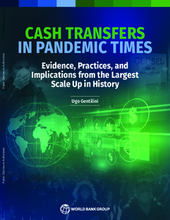Is COVID-19 a “game changer” for cash transfers? This paper offers some clues to address the question by bringing together data, evaluations and practical experiences generated over the course of the pandemic. In particular, the paper discusses the differences between COVID-19 and other crises; it lays out an anatomy of global responses and offers novel data analysis around stylized international trends; synthesizes fresh empirical evidence on response effectiveness based on over 40 evaluations; discusses country level operational practices as emerging from an array of high and lower-income contexts; and distills key insights with possible future implications.
Ten facts emerge from global trends in cash transfer responses:
- Cash transfers reached unprecedented levels of coverage, but unevenly so across countries and largely concentrated in the early phase of the pandemic. About 66% of those measures were introduced in the first semester of 2020. Cash transfers reached 1.36 billion individuals, that is, one out of six people in the world received at least one cash transfer payment. About half of the population of East Asia and North America were covered, while about one-tenth of Africa’s was so.
- Cash transfers were of short duration and uncertain in extension. The average duration of cash transfers was only 4.5 months. Where these were extended, or in 16% of cases with available data, they were so for an additional 6.3 months on average. Program extensions were highly uncertain in their outcome. Duration choices may be in no small measure due to the uncertainty surrounding the direction of the crisis and its waves. Yet there seems to be no correlation between the duration of severe containment policies and the duration of cash transfers.
- Transfers were generous, but likely not enough to counter forgone labor incomes. Covid-19 cash transfers were 70% higher than in the pre-2020 period. The amount of cash received by beneficiaries represented an average of 46% of median income. Yet evidence shows that such generosity may have not been sufficient to offset the temporary or permanent loss of livelihoods incurred over the pandemic, especially among vulnerable but not the poorest people. This is corroborated by empirical studies showing that cash transfers provided significant support in mitigating the effects of the pandemic, but without countering its full impact.
- Governments simplified the design of cash transfer programs in several ways. In-kind transfers were in some cases converted into cash; transfers were made easier to access, were mostly unconditional, and eligibility was simplified. In specific cases, transfers were adjusted in subtle ways to ensure relatively fast and localized spending, but without turning them into quasi-cash (or voucher) transfers. A range of practical innovations introduced during Covid-19 were absorbed into routine delivery systems.
- Most responses relied on introducing new programs through various identification and registration mechanisms. Most cash transfers were introduced afresh. The identification of beneficiaries mostly relied on open registration, social registries, and tax databases. Among registration mechanisms, online platforms were the most widely utilized.
- Most cash transfers were paid digitally. A total of 763 million people were reached by digital cash transfers. Digital payments yielded a number of benefits, including making people more likely to receive transfers on a timely basis. However, access to digital payments can be hindered at several levels and can amplify exclusion. It is key to ensure the alignment of payment models with contextual user capabilities and payment ecosystems.
- Preexisting social protection delivery systems helped responses significantly, but they were not always a necessary nor sufficient condition for scale-up. The social protection responses to Covid-19 underscored the fundamental importance of delivery systems. However, these were often unable to reach people at the middle or so of the income distribution. This speaks to the salience of recognizing the importance of all delivery building blocks, and not just some (e.g., payments or registries), the relevance of interoperable government databases across sectors, as well as considering both public and private sector infrastructure in delivery capacity assessments.
- The timeliness of transfers varied substantially. On average, coverage scale-up (horizontal extension) took 26 days, with timeliness ranging from 2 to 119 days. The increase in benefits (vertical expansion) was faster, taking an average of 18 days (varying between 0 and 67 days). Programs that were preexisting and using social registries were faster. The delivery of payments in high income countries shed light on a range of challenges also in those settings.
- Governments moved centerstage, but civil society actors played an important role. A qualitative reading of the overall Covid experience indicates that governments embraced the crisis response in ways that are more visible and deliberate than in other circumstances. This is likely because of the role states played in managing the crisis. The pandemic has accelerated linkages between international humanitarian assistance and domestic social protection. National and local civil society actors were also called for widespread engagement in direct provision of assistance.
- Record-level global spending was highly uneven across countries, with financing based on a range of sources. Average spending on social protection amounted to an average of 2% of GDP, three-quarters of which was devoted to social assistance. With a global average of $313/capita, high-income countries display a level of injection about 93 times higher than low-income countries. Domestic financing of responses occurred via transfers from the existing budgets, budgetary reallocation, contingency funds, and in some cases taxation. These were complemented by extra budgetary mechanisms with various degrees of alignment with national budgets. Private donations were also an important part of the financing mosaic.

